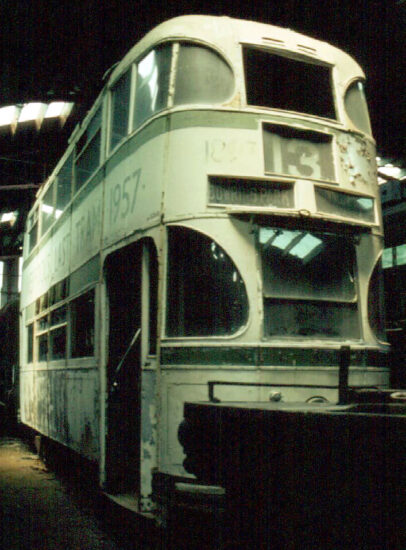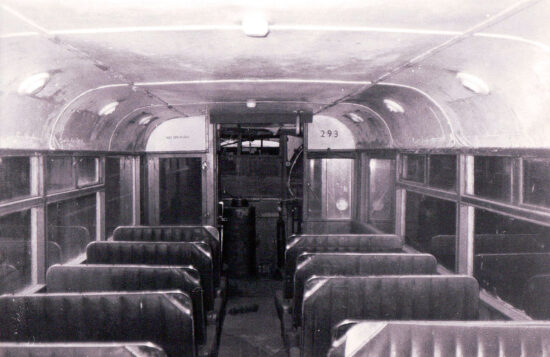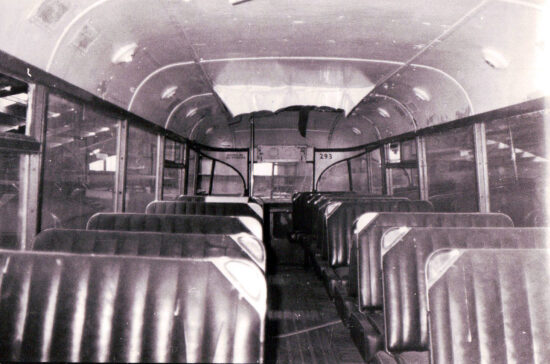We recently featured a story on the UK trams which are housed at the Seashore Trolley Museum in Kennebunkport, Maine with an article having been run in their member’s magazine in early 2020 giving more details on their acquisition back in the 1960s. Our article has jogged some memories of the trams in the US and in this follow-up we feature some images of Liverpool 293 from Norman Daley.
Liverpool 293 has been in the United States of America far longer than it was ever in service in Liverpool having been transported aboard the S.S. American Packer in 1958 and being officially presented to the museum by then British Consul General Robert H.K. Marrett at Kennebunkport’s Memorial Day Parade. The tram itself was one of 100 Baby Grands built in 1939 and ended up being the last tram to run on Liverpool Corporation Tramways on 14th September 1957 as part of the final procession.
Following the closure of the tramway there were no takers for the tram in the UK and so it was acquired by Seashore for preservation. Although it has been in the USA for 62 years it has never run and is stored undercover in one of their car barns.
The below photos were taken in May 2003.




It should never have gone!
This is a classic example of the White Elephant – something given as an unwanted gift like the German trams given to Leicester way back when nothing could be done with them except to let them rot. I expect the tram is in even worse condition after 18 more years in a shed. When the custodians have no historic or emotional connection with a tram, then its possession becomes a liability and nothing can be done with it. If repatriated to Liverpool, then it would be treaded with respect and pride. It ought to follow the Burton and Ashby car back to its country of origin.
Having had several contacts with many of the museums in the USA, if a solid project was proposed to them, I am sure that the end result would be a win – win for all. But for that to happen, a viable project needs to be presented, and most importantly with the financial backing. Twelve years ago I arranged the shipping of a historical double deck bus back from California to the UK, and the cost was close to £5k at that time. With the recent increases in worldwide shipping charges, the cost of the transport from its current position to a suitable facility in the UK would be in the region of £12 – £15k. And that is before any restoration work starts. Deep pockets required, and as usual no-one is ready to put some serious sums of money on the table to make such a project happen.
Sigh, here we go again! Maybe the tram shouldn’t have gone to the USA, but where would it have gone otherwise? The scrapyard, almost certainly. I’m thankful someone actually saved it, and although these pictures aren’t that recent, its condition didn’t look too bad then really!
No doubt it should have never gone to the USA and yes if it had remained it would have survived. We would probably be riding it today at Birkenhead. What we would have lost however is Baby Grand 245 which was saved after Liverpool Museums asked, rather belatedly, for a tram to be kept. So fate dealt a strange hand and we now have two Baby Grands when we would certainly only have had one.
Subjectively the transportation costs quoted above seem low. The tram cannot be split into 2 decks and so would probably have to be shipped as deck cargo. I understand that if Seashore would be prepared to release the tram it would require a payment to recognise that it preserved the tram in the first instance. I have been told that this would in the region of $20,000. Seashore would also require a restoration plan for the vehicle. You may recall that the press release for restoration Blackpool 298 included an estimated cost of £373,000. Bearing that in mind the cost of paying Seashore, shipping and restoring the tram could exceed £500,000, assuming that the tram could stored under cover free of charge. It’s not impossible but it would need considerable effort and people’s generosity.
Given that repatriation of items to their country of origin is now a major issue in museum circles, and that Seashore did not acquire the tram by legal purchase but by gift, can the protocols used to repatriate other items given as gifts, like the ‘Ghost Shirt’ returned to the Lakota Sioux by Kelvingrove Art Gallery and Museum in Glasgow, received originally as a gift, be applied?
Its hardly in the same league as the Ghost shirt. And anyway, to repeat whats being said. Whose paying?